Moisture doesn’t just ruin your phone or your books-it can wreck your medicine. If your pills or capsules feel sticky, discolored, or smell odd, they might already be damaged. And that’s not just a waste of money. Moisture can break down the active ingredients, making your meds less effective-or even harmful. Aspirin turns into vinegar and salicylic acid. Vitamin C oxidizes fast. Antibiotics like amoxicillin lose potency. In humid climates or during long-term storage, this isn’t rare. It’s predictable. And it’s preventable.
Why Moisture Destroys Pills and Capsules
Pills and capsules aren’t just little pills. They’re engineered chemical systems. Many active ingredients, especially those in antibiotics, vitamins, and pain relievers, react badly with water. This isn’t speculation-it’s chemistry. Hydrolysis breaks molecular bonds. Oxidation creates toxic byproducts. The FDA has issued warning letters to manufacturers because of this. In 2022, 67% of U.S. medication shortages tied to quality issues were linked to moisture degradation.Even if your bottle looks fine, the damage is happening inside. A typical 500-pill bottle gets opened about 250 times over its lifespan. Each time, moist air rushes in. That air doesn’t just sit there-it gets absorbed. Over time, the moisture builds up. By the time you’re on your last 50 pills, the environment inside the bottle is far worse than when you first opened it.
Some drugs are worse than others. Vitamin C, aspirin, and antibiotics like amoxicillin-clavulanate are extremely sensitive. Even in dry climates, humidity from your bathroom or kitchen can creep in. If you keep your meds near the sink, shower, or stove, you’re exposing them to daily steam cycles. That’s why medicine stored in a bathroom cabinet often fails long before its expiration date.
How Film Coating Protects Your Pills
The best defense starts before the pill leaves the factory. Advanced film coatings act like armor. Not all coatings are the same. Most older pills use hydroxypropyl methylcellulose (HPMC), which offers basic protection. But newer coatings, like polyvinyl alcohol (PVA)-such as Colorcon’s Opadry® amb II-perform dramatically better.Studies show PVA coatings reduce water vapor transmission by 30-40% compared to HPMC. In one test, uncoated and HPMC-coated amoxicillin tablets lost nearly all their clavulanic acid after just 10 days outside packaging. The PVA-coated ones? Still fully potent. That’s not a small difference. It’s the difference between your antibiotic working and failing.
Manufacturers use these coatings because they’re reliable. They don’t crack when pills are shaken. They don’t peel off in humid storage. And they work even if the outer packaging gets compromised. That’s why pharmacies reporting fewer complaints after switching to PVA-coated meds-some went from five monthly complaints to zero.
But here’s the catch: you can’t see the coating. You won’t know if your pills have it unless you check the manufacturer’s website or ask your pharmacist. If you’re buying generic meds, ask: “Do these have a moisture-resistant film coating?” If they say no, consider switching brands. Your health isn’t worth the 15-20% savings.
Desiccants: The Silent Guardians in Your Bottle
Even the best coating can’t stop moisture once the bottle is open. That’s where desiccants come in. Silica gel is the gold standard. It’s cheap, non-toxic, and can absorb up to 40% of its own weight in moisture. A properly sized silica gel pack in a 500-pill bottle can limit moisture increase to just 0.3% over two years-even in 50% humidity.But size matters. Too small, and it’s useless. Industry best practice says the desiccant must handle at least 150% of the expected moisture load. For a typical 500-pill bottle with 250+ openings, that means a 1-2 gram pack. Many manufacturers use half that. The FDA has cited companies for exactly this mistake.
Look for a small pouch labeled “silica gel” or “do not eat” inside your pill bottle. If it’s missing, don’t assume it’s unnecessary. Ask your pharmacist to add one. Many pharmacies now include them automatically, especially for moisture-sensitive drugs. If you refill at a chain pharmacy, request a desiccant pack. It’s free, and it’s life insurance for your meds.
Wisesorbent’s customer reviews on Trustpilot show 4.7/5 stars from over 80 users, mostly praising how their silica packs stopped pills from sticking in tropical climates. One user in Brazil wrote: “My insulin pills used to get gummy. Now they’re fine.” That’s the power of the right desiccant.
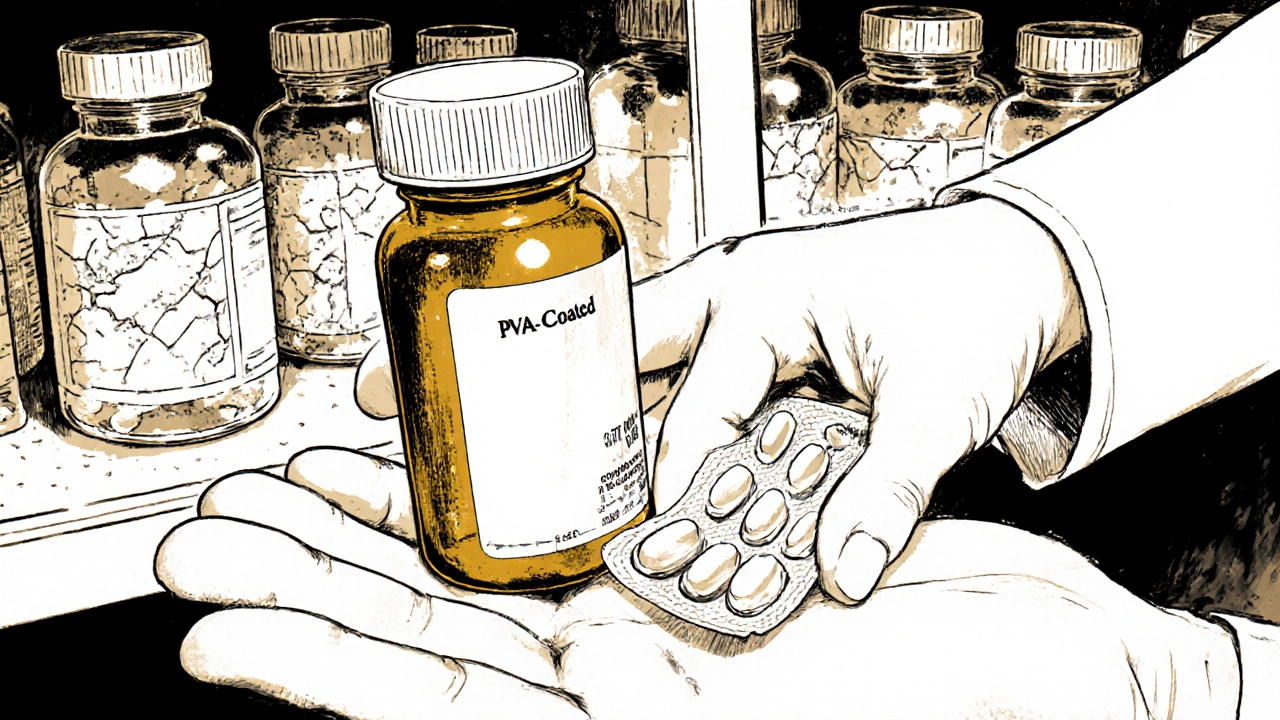
What Packaging Actually Works
HDPE (high-density polyethylene) bottles are common. They’re cheap and shatterproof. But they’re not moisture-proof. Water vapor passes right through them. Same with PP (polypropylene). These materials protect against spills and dust, but not humidity.Aluminum blister packs are better-they’re nearly impermeable. But they’re not practical for daily use. You can’t easily carry a blister pack in your purse. And once you peel off a pill, the rest are exposed.
The best packaging combines layers: a moisture-resistant bottle (like Tyvek) + a properly sized desiccant + a PVA-coated tablet. That’s the trifecta. Companies that use this combo report near-zero moisture-related returns. Those that rely on HDPE alone? They see returns, complaints, and FDA warnings.
If you’re storing meds long-term-say, for travel, emergencies, or seasonal use-transfer them to airtight glass jars with silica gel. Glass doesn’t breathe. And always label the jar with the drug name and expiration date.
Where NOT to Store Your Medications
Bathroom cabinets are the worst place. The steam from showers and sinks creates daily humidity spikes. Kitchens are next-near the stove, dishwasher, or coffee maker. Even your bedroom might be too warm if you keep meds near a heater or window that gets direct sun.The ideal spot? A cool, dry drawer in a bedroom or hallway. Temperature should stay below 77°F (25°C). Humidity should be below 60%. If you live in a humid area like Texas or Florida, consider a small dehumidifier in your bedroom. Or use a sealed container with silica gel inside your drawer.
Don’t leave pills in your car. Even in winter, temperatures swing wildly. In summer, inside a car can hit 140°F. That’s enough to melt capsules and trigger chemical reactions. No matter how “safe” the label says it is, heat and moisture together are deadly.

What to Do If Your Pills Are Already Damaged
If you notice any of these signs, stop using the pills:- Sticky or clumped tablets
- Discoloration (yellowing, dark spots)
- Cracking or crumbling when touched
- Unusual odor-like vinegar, mildew, or chemical smell
- Capsules that are swollen, soft, or leaking
Don’t throw them in the trash. Don’t flush them. Return them to a pharmacy that offers a drug take-back program. Many pharmacies now have drop-off bins for expired or damaged meds. If yours doesn’t, check with your local health department. The EPA recommends this for safety and environmental reasons.
Using damaged pills can lead to treatment failure. If you’re on antibiotics, that could mean a lingering infection. If you’re on blood pressure or heart meds, it could be dangerous. Never guess. When in doubt, toss it and get a new prescription.
Pro Tips for Long-Term Protection
- Buy only what you need. Don’t stockpile meds unless necessary. The longer they sit, the higher the risk.
- Use a pill organizer only if it’s airtight. Most plastic organizers are porous. Look for ones with rubber seals.
- Write the opening date on the bottle. Track how long it’s been open. Most meds lose stability after 6-12 months of exposure.
- Ask your pharmacist: “Is this medication moisture-sensitive?” If yes, request a desiccant and confirm the coating type.
- Keep meds in original packaging. It’s designed for protection. Don’t transfer unless absolutely necessary.
- For travel, use a small, hard-shell container with a silica gel pack. Avoid ziplock bags-they’re not sealed enough.
What’s Changing in the Industry
Manufacturers are moving toward smarter solutions. New coatings are being developed that don’t just block moisture-they actively absorb it. Some companies are testing color-changing labels that turn red if moisture levels rise. Others are using biodegradable desiccants made from plant starches.The market for pharmaceutical desiccants is growing fast-projected to hit $1.8 billion by 2027. Why? Because people are demanding better. Pharmacists are pushing back. Patients are reporting failures. And regulators are cracking down.
What’s next? Integrated protection. Imagine a pill that has its own moisture scavenger built into the core. That’s already in development. But until then, your best tools are simple: coating, desiccant, and proper storage.
Can I use silica gel packets from shoeboxes or electronics for my pills?
No. Silica gel from shoeboxes or electronics isn’t pharmaceutical-grade. It may contain additives, dyes, or contaminants. Only use desiccants labeled for pharmaceutical use. They’re tested for safety and purity. Using non-medical silica gel could introduce toxins into your medication.
Do all prescription pills have moisture-resistant coatings?
No. Many generics, especially older ones, still use basic HPMC coatings. Brand-name drugs and newer formulations are more likely to use advanced PVA coatings. Always ask your pharmacist if your medication is moisture-sensitive and whether it has a protective coating.
How often should I replace the desiccant in my pill bottle?
You don’t need to replace it. Once the desiccant is saturated, it stops working-but it doesn’t harm the pills. Most packs last the full shelf life of the medication. If you notice the pack is hard or crumbly, it’s likely done its job. Replace it only if you’re transferring pills to a new container.
Is it safe to store pills in the refrigerator?
Only if the label says so. Refrigeration can cause condensation when you take the bottle out, which increases moisture exposure. Most pills are fine at room temperature. Unless your medicine requires refrigeration (like insulin or some liquid antibiotics), keep it dry and cool-don’t put it in the fridge.
Can moisture damage cause side effects?
Yes. Degraded aspirin can irritate your stomach. Broken-down antibiotics may cause incomplete treatment and antibiotic resistance. Some degraded compounds can be toxic. If your pills look or smell off, don’t take them. The risk isn’t worth it.
If you’re taking medications long-term, especially in a humid climate, treat them like electronics: keep them dry, cool, and protected. A few simple steps can save you from dangerous failures. Don’t wait for a bad reaction. Prevent it now.
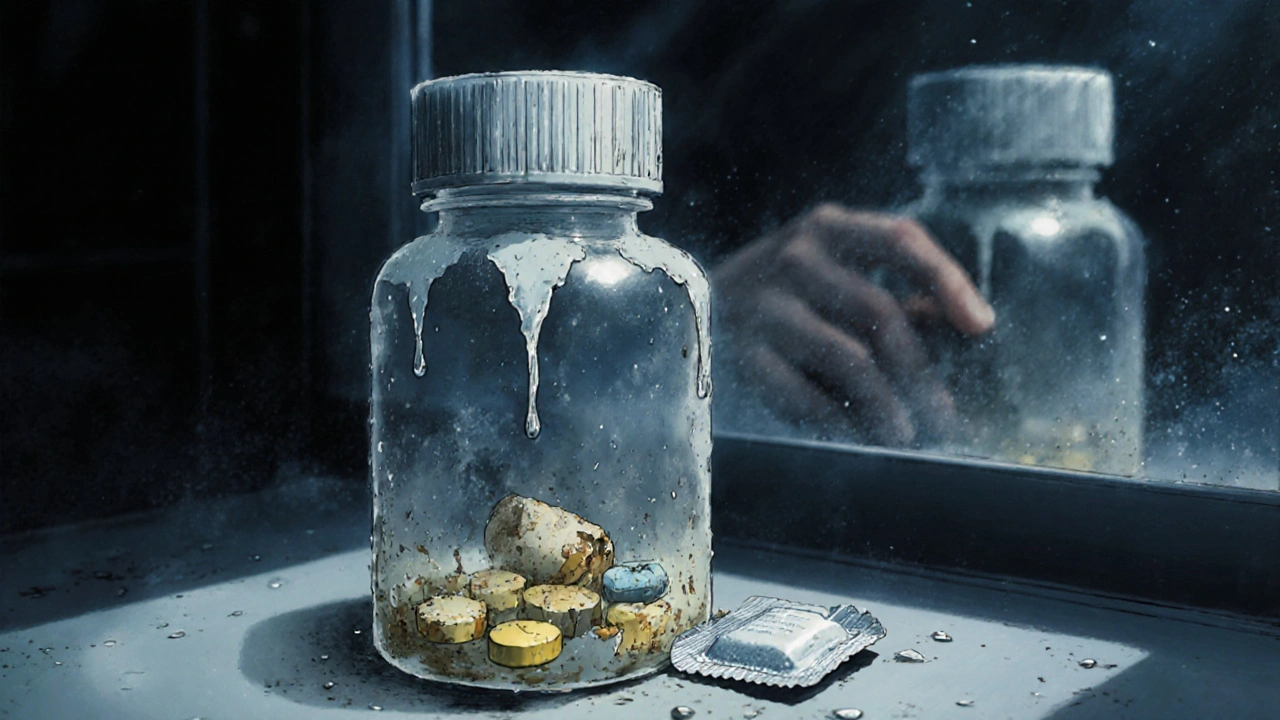


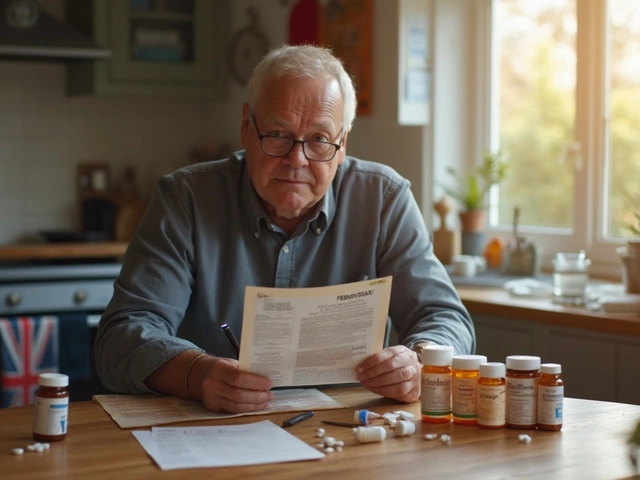
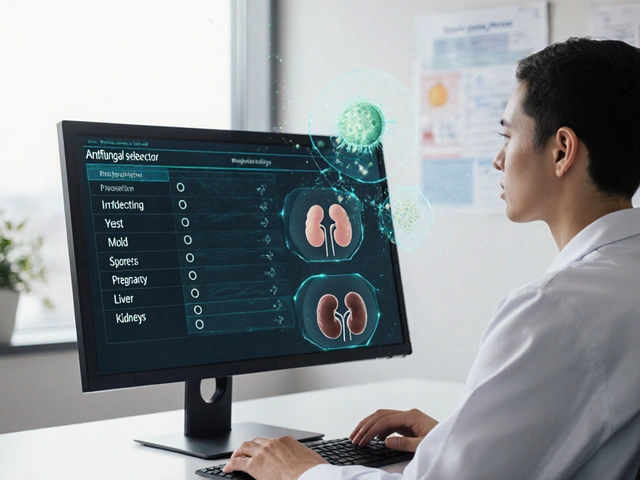
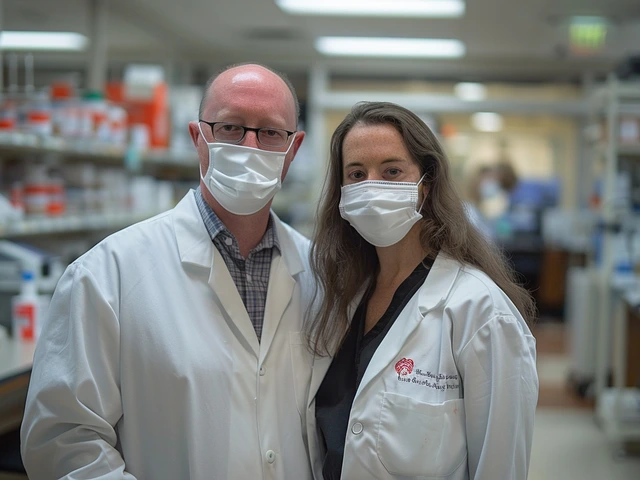
Erika Lukacs
15 November 2025 - 23:21 PM
It's funny how we treat medicine like it's just another household item, like cereal or soap. We don't think about the chemistry behind it until something goes wrong. But pills? They're tiny time bombs waiting for humidity to trigger their decay. We store them in steamy bathrooms like it's normal, then wonder why they stop working. Maybe we need to stop treating our bodies like afterthoughts and start treating our meds like the precision tools they are.
Rebekah Kryger
16 November 2025 - 03:51 AM
Let’s be real-most of this is marketing fluff. PVA coatings? Silica gel? Please. Your pills are fine. The FDA doesn’t care if your aspirin smells like vinegar. If your meds are expired, get new ones. Stop overcomplicating it. Also, ‘pharmaceutical-grade silica’? That’s just fancy sand. You’re not storing plutonium.
Victoria Short
17 November 2025 - 21:23 PM
I just keep my pills in the bathroom. It’s convenient. They’ve never exploded. I don’t know what ‘hydrolysis’ means. I just know if they look weird, I don’t take them. That’s my system. Works fine.
Eric Gregorich
18 November 2025 - 09:52 AM
Think about it: we live in a world where we’ll spend $200 on a phone case to protect a device that lasts two years, but we toss our life-saving meds into a plastic bottle that breathes like a sieve and leave it in a steam room. We’re not careless-we’re tragically disconnected from the fragility of our own biology. The coating on that pill? It’s not just polymer-it’s the last line of defense between you and a failed treatment, a lingering infection, maybe even death. And yet, we treat it like an afterthought. We optimize our coffee makers but not our survival. That’s not ignorance. That’s a spiritual crisis wrapped in a pharmacy receipt.
Koltin Hammer
18 November 2025 - 17:52 PM
I grew up in rural Texas where the humidity made everything sticky-socks, books, your skin. My grandma kept her meds in a sealed Tupperware with silica packs from her shoebox. She lived to 98. I used to think she was just old-school. Now I know she was a survivalist scientist. The real tragedy isn’t the lack of PVA coatings-it’s that we’ve forgotten how to care for things that care for us. Medicine isn’t disposable. It’s sacred. And we treat it like last week’s takeout.
Phil Best
20 November 2025 - 03:48 AM
Oh wow. So now I’m supposed to become a pharmaceutical engineer just to take my blood pressure pills? Let me get this straight-I can’t store my meds where I actually use them (the bathroom), I need to buy special silica gel that’s not from my dryer sheets, and I have to ask my pharmacist if my generic pills have a ‘moisture-resistant film coating’ like it’s a Tesla feature? I’m not paying $150 a month for meds so I can become a lab tech. Just tell me if it’s safe or not. And if it’s not? Stop selling it.
Parv Trivedi
21 November 2025 - 07:03 AM
In India, we have a saying: ‘If the medicine is good, it will survive the heat.’ But I’ve seen too many people lose their antibiotics to monsoon humidity. I always keep my pills in a sealed container with a silica pack-bought from the pharmacy, not the shoe store. I also write the opening date on the bottle. It’s simple. No fancy science. Just respect. Your health is not a gamble. Treat it like the gift it is.
Willie Randle
21 November 2025 - 11:08 AM
One correction: the FDA does not issue warning letters to manufacturers solely for moisture degradation. They issue them for violations of Current Good Manufacturing Practices (cGMP), which include inadequate packaging, insufficient desiccant sizing, and failure to validate stability under real-world conditions. This post conflates regulatory outcomes with chemical processes. That said-the core advice is sound. Use glass containers for long-term storage. Verify coating types. Request desiccants. And never store meds above 77°F. These aren’t suggestions. They’re evidence-based protocols. Ignoring them isn’t convenience-it’s negligence.
Connor Moizer
22 November 2025 - 06:54 AM
You’re overthinking this. If your pills are sticky, they’re bad. Throw them out. Buy new ones. Stop reading 5000-word essays on hydrolysis. You’re not saving money by hoarding meds-you’re risking your life. And if your pharmacist doesn’t give you a desiccant? Find a new one. Your health isn’t a bargaining chip. Stop being passive. Be aggressive about your care. That’s not paranoia. That’s responsibility.
kanishetti anusha
22 November 2025 - 20:21 PM
I’m from rural India, and we’ve always kept our medicines in dry, dark places-even before we knew the science. My aunt used to wrap her insulin in cloth and store it under her bed. She lived with diabetes for 40 years. I think we lost something when we started trusting packaging more than instinct. But now I know: it’s not about tradition. It’s about science. So I use airtight jars. I ask my pharmacist. I write dates. I don’t take risks. Small habits. Big impact.
roy bradfield
23 November 2025 - 10:16 AM
Did you know the pharmaceutical industry is secretly using silica gel to track your consumption? That’s why they make you ‘open’ the bottle so many times-it’s a data harvest. The coating? It’s not for moisture. It’s for RFID. The FDA? They’re in on it. Your pills are being monitored. Your body is the experiment. They want you to think it’s about ‘stability’-but it’s about control. Silica gel is a surveillance tool. Don’t be fooled. The real danger isn’t humidity-it’s the system that wants you to believe you need to fix it yourself.
Patrick Merk
24 November 2025 - 22:16 PM
Love this. I’m from Dublin, and our weather is basically a damp sock wrapped around a fridge. I used to keep my meds in the kitchen cupboard-big mistake. Once, my vitamin D tablets turned into a chalky paste. I thought I was going mad. Then I learned about desiccants. Now I keep them in a glass jar with a silica pack from the pharmacy. No more mystery gloop. Also, I write the date on the bottle. It’s like a diary for my health. Small things. Huge peace of mind.
Liam Dunne
25 November 2025 - 00:43 AM
My dad’s a retired pharmacist. He told me a story about a guy who kept his blood thinner in the car because ‘it was convenient.’ One summer, the pill bottle melted into the dashboard. The guy didn’t notice until he passed out. Turned out the meds were half-degraded. He ended up in the ER with a stroke. The point? Your meds aren’t snacks. They’re precision instruments. Treat them like your phone-no steam, no sun, no trash bins. If you wouldn’t leave your laptop in a hot car, don’t leave your meds there either.
Vera Wayne
25 November 2025 - 23:56 PM
Thank you for this. So many people don’t realize how dangerous moisture is. I used to keep my insulin in the bathroom. I didn’t know. Now I use a sealed glass jar with a silica pack in my bedroom drawer. I even labeled it. I feel safer. And I tell everyone I know. It’s not complicated. Just don’t be lazy.
Rodney Keats
27 November 2025 - 23:20 PM
So now I need to become a chemist to take a pill? Next you’ll tell me I need to calibrate my aspirin with a hygrometer. I’m just trying to survive. Not run a lab.